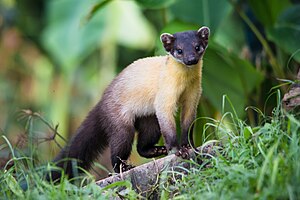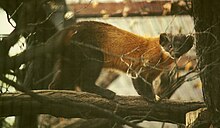Red marten
| Red marten | ||||||||||||
|---|---|---|---|---|---|---|---|---|---|---|---|---|

Great Red Marten ( Martes flavigula ) |
||||||||||||
| Systematics | ||||||||||||
|
||||||||||||
| Scientific name | ||||||||||||
| Martes flavigula | ||||||||||||
| ( Boddaert , 1785) |
The great spotted marten ( Martes flavigula ) is an Asian species of marten that is distributed from southeastern Siberia via China and the Malay Peninsula to Borneo and Java . Together with the Indian charsa or the Indian great marten , it forms the subgenus Charronia within the genus of the real marten ( Martes ).
features
The fur of the great marten is predominantly light brown in color. Their head, legs, the back of their torso and tail are dark brown or black. Similar to the pine marten , they have a yellowish throat patch. The Indian red marten, which is widespread in southern India, is very similar to the red marten. The differences between the two types are mainly in the shape of the skull, which is significantly flatter in the Indian Charsa. Great martens reach a head-trunk length of 45 to 65 cm, a tail length of 37 to 45 cm and a weight of 2 to 3 kg.
Way of life
Red martens are diurnal forest dwellers and mainly look for food on the ground, but they can also climb very well. Their diet includes mammals such as rodents and whistling hares , bird eggs, frogs , insects , honey and fruits. Sometimes they also kill offspring of musk deer and other cloven-hoofed animals. In times of food shortages, they also eat carrion , snakes and lizards, as well as insects.
threat
Unlike many other species of marten, the great red marten has never been hunted on a large scale for their fur. As they sometimes break open beehives because of their preference for honey and their meat is eaten in some regions, they are persecuted, but the main threat is habitat loss through deforestation. The species as a whole is currently not considered threatened. However, the Javanese subspecies ( M. f. Robinsoni ) is classified as endangered.
Subspecies
There are six subspecies of the great spotted marten:
- M. f. flavigula - Bangladesh , Bhutan , Central, East and South China, Nepal, Pakistan
- M. f. borealis - Northeast China, Korea, Far East Russia
- M. f. chrysophila - Taiwan
- M. f. indochinensis - Cambodia, Laos, Myanmar, Thailand, Vietnam
- M. f. peninsularis - Borneo , Sumatra , Mayan Peninsula
- M. f. robinsoni - Java
literature
- Ronald M. Nowak: Walker's Mammals of the World. 2 volumes. 6th edition. Johns Hopkins University Press, Baltimore MD et al. 1999, ISBN 0-8018-5789-9 .
Web links
- Martes flavigula inthe IUCN 2013 Red List of Threatened Species . Posted by: Abramov, A., Timmins, RJ, Roberton, S., Long, B., Than Zaw & Duckworth, JW, 2008. Retrieved January 22, 2014.
Individual evidence
- ↑ Tej Kumar Shrestha: Wildlife of Nepal - A Study of Renewable Resources of Nepal Himalayas. Tribhuvan University, Kathmandu 2003, ISBN 99933-59-02-5 , p. 127.
- ↑ a b S. Lariviere, AP Jennings: Family Mustelidae (Weasels and Relatives). In: DE Wilson, RA Mittermeier (ed.): Handbook of the Mammals of the World. Volume 1: Carnivores. Lynx Edicions, 2009, ISBN 978-84-96553-49-1 , p. 629.

